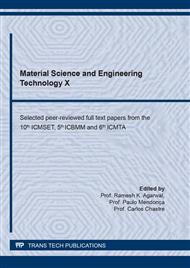p.157
p.165
p.170
p.176
p.185
p.191
p.199
p.205
p.212
Welding Parameter Optimization for Improvement of Mechanical Strength of Weld Line
Abstract:
In this study, MIG welding parameters were optimized by experts. The results showed that heat input affected the welding of all five specimens, and similar structural changes were observed. The part adjacent to the weld line, using low HI (BM) lower than the melting point, increased the grain size and decreased the average hardness (87 HV) at HAZ. In comparison, high HI (WZ) at melting point resulted in fine grain with a high hardness of 126.8 HV and tensile strength of 686 MPa. Nevertheless, fatigue testing revealed that the specimens suffered a brittle fracture under a slight load cycle of 104 Nf. Correlation analysis of HI, mechanical properties and optimization plot revealed the optimum HI of 363 J/mm, and the verification by fatigue testing showed the optimum load cycle of 106 Nf. However, the determination of maximum strength should be done using several techniques for more effective improvement of quality and yield using the research findings of this study.
Info:
Periodical:
Pages:
185-190
Citation:
Online since:
February 2022
Authors:
Price:
Сopyright:
© 2022 Trans Tech Publications Ltd. All Rights Reserved
Share:
Citation:


